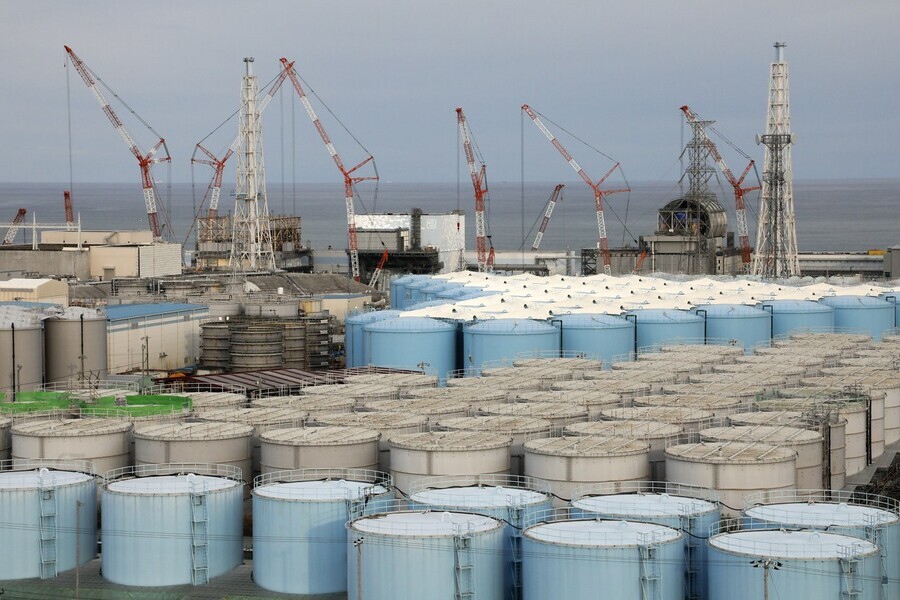hankyoreh
Links to other country sites 다른 나라 사이트 링크
IAEA’s report fails to assess impact of Fukushima water dumping on marine food chain

Few who have been watching the situation would have been surprised by the conclusion that the International Atomic Energy Agency (IAEA) reached in its final report on Thursday. Its decision that Japan’s plan to discharge contaminated water from the Fukushima Daiichi nuclear power plant into the sea is “consistent with international safety standards” was already foreshadowed by six interim reports dating back to April 2022.
Most notably, it concluded that “gradual discharges of the treated water to the sea, as currently planned and assessed by TEPCO, would have a negligible radiological impact on people and the environment.”
The IAEA did not include in its final report any verification of the performance of the Advanced Liquid Processing System (ALPS), a key facility responsible for reducing the radionuclide content of the contaminated water to below the permissible limit for discharge.
This lack of verification was based on a radiological environmental impact assessment conducted by TEPCO, Japan’s electric power corporation, which concluded that the contaminated water from the Fukushima plant was as safe as discharges from other nuclear plants in other countries.
This report presents the results of the IAEA’s review of the safety of the Fukushima contaminated water discharge plan that began in September 2021.
The review was divided into eight areas, including the radioactive characteristics of the water to be released, safety-related aspects of the systems and processes to control the release, the radiological environmental impact assessment (REIA), regulations and approvals for the release, the monitoring program, stakeholder engagement, and occupational radiation protection.
In the chapter of the report that reviewed the REIA, the IAEA said that, based on TEPCO’s assessment, “activity concentrations in international waters will not be influenced by the discharge of ALPS treated water into the sea and the transboundary impacts are therefore negligible.”
In the assessment, TEPCO used calculations based on an ocean dispersion model to predict that the area where tritium concentrations above 1 becquerel per liter would be expected would be limited to waters within three kilometers of the Fukushima Daiichi plant, and that the average tritium concentration in the surface waters 10 kilometers in all directions would be only 0.12 becquerels per liter.
The chapter reviewing the “protection of present and future generations and their environment” also concluded that “TEPCO’s marine dispersion models predict very insignificant concentrations of tritium and other radionuclides that will be undetectable or indistinguishable from background levels at the boundary of the modelling simulation area.”
“The results of the radiological environmental impact assessment show that the estimated dose to populations in neighbouring countries will be negligible,” it read.

The report also stated that, as the dose rates to three representative marine species (flat fish like flounders, crabs, and brown seaweeds) are more than one one-millionth lower than the reference levels set by the International Commission on Radiological Protection. “The IAEA is confident that the international environmental protections objectives will be amply met by the controls in place for the discharge of ALPS treated water and that the dose rates to biota are negligible compared to the international safety criteria set by ICRP.”
In Japan, the government and ruling party emphasize that the discharge of contaminated water will have a negligible impact on the country based on simulations of the spread of these radionuclides in the ocean.
However, these simulation results only explain the timing and concentration of tritium in domestic waters. They are far from a comprehensive assessment of the biological effects of radioactive material released into the ocean, including its accumulation through the food chain.
Greenpeace and other environmental organizations have pointed out that the environmental impact assessment, which is based on marine dispersion models, does not take into account the impact on marine ecosystems and neighboring countries, including South Korea.
Furthermore, the radioactive water discharge plan is predicated on the stable operation of the ALPS throughout the discharge period, which will keep the radionuclide content of the contaminated water below the permissible discharge threshold.
However, the IAEA and Japan have a fundamental limitation in their review of the discharge plan in that they have included the facilities to transport and dilute the contaminated water as subjects of monitoring, but not the system, ALPS, that will filter it.
In May, Korea announced that it would soon announce the results of verifying the performance of ALPS by analyzing the raw data of contaminant concentrations at the entrance and exit of ALPS obtained during the site inspection of the Fukushima Daiichi nuclear power plant.
However, it is unlikely that the results of the analysis of the data provided by the Japanese government, without verification through sample analysis, will resolve concerns about the reliability of ALPS.
By Kim Jeong-su, senior staff writer
Please direct questions or comments to [english@hani.co.kr]

Editorial・opinion
![[Editorial] Intensifying US-China rivalry means Seoul must address uncertainty with Beijing sooner than later [Editorial] Intensifying US-China rivalry means Seoul must address uncertainty with Beijing sooner than later](https://flexible.img.hani.co.kr/flexible/normal/500/300/imgdb/original/2024/0517/8117159322045222.jpg) [Editorial] Intensifying US-China rivalry means Seoul must address uncertainty with Beijing sooner than later
[Editorial] Intensifying US-China rivalry means Seoul must address uncertainty with Beijing sooner than later![[Column] When ‘fairness’ means hate and violence [Column] When ‘fairness’ means hate and violence](https://flexible.img.hani.co.kr/flexible/normal/500/300/imgdb/original/2024/0516/7417158465908824.jpg) [Column] When ‘fairness’ means hate and violence
[Column] When ‘fairness’ means hate and violence- [Editorial] Yoon must stop abusing authority to shield himself from investigation
- [Column] US troop withdrawal from Korea could be the Acheson Line all over
- [Column] How to win back readers who’ve turned to YouTube for news
- [Column] Welcome to the president’s pity party
- [Editorial] Korea must respond firmly to Japan’s attempt to usurp Line
- [Editorial] Transfers of prosecutors investigating Korea’s first lady send chilling message
- [Column] Will Seoul’s ties with Moscow really recover on their own?
- [Column] Samsung’s ‘lost decade’ and Lee Jae-yong’s mismatched chopsticks
Most viewed articles
- 1[Editorial] Transfers of prosecutors investigating Korea’s first lady send chilling message
- 2[Exclusive] Unearthed memo suggests Gwangju Uprising missing may have been cremated
- 3S. Korea “monitoring developments” after report of secret Chinese police station in Seoul
- 4[Editorial] Intensifying US-China rivalry means Seoul must address uncertainty with Beijing sooner t
- 5Could Korea’s Naver lose control of Line to Japan?
- 6Korea cedes No. 1 spot in overall shipbuilding competitiveness to China
- 7[Column] US troop withdrawal from Korea could be the Acheson Line all over
- 8China, Russia put foot down on US moves in Asia, ratchet up solidarity with N. Korea
- 9Xi, Putin ‘oppose acts of military intimidation’ against N. Korea by US in joint statement
- 10Korea’s first openly trans athlete hopes to prompt a discussion by competing as herself